Namaste Readers,
I write this in the shadow of renewed conflict between India and Pakistan, where innocent lives have been lost, including Indian tourists in Pahalgam. My heart aches for the people of Jammu and Kashmir, and I condemn all acts of terror that shatter peace. As this essay takes shape, may it carry an intention for peace—for only in such intention can peace prevail.
It is an unusual summer here in India. The sun feels ominously close—we can feel him, but we can’t often see him. The intense heat, longer days, and blazing sunlight, which are trademark features of nature’s brutality in these parts of the world, have now been subdued by storms brewing over the Bay of Bengal, bringing with them constant showers accompanied by windless, humid inactivity. The atmosphere—half grey with clouds and half blanketed in humidity and smoke—is highly uncharacteristic of an Indian summer. I wouldn’t say it is not hot. It is hot, but in a suffocating, breathless way—as if the very air has been squeezed out by an invisible brute. The grey, stagnant sky hangs low over our homes, and the days spiral into a humid stupor, neither monsoon nor summer in its full truth.
I know all that sounds complicated—because it precisely is. This is not how I remember my childhood summers to be. It worries me deeply. These may be the early signs of the climate crisis tipping into something far more insidious. Just look at these heat maps comparing this year’s summer to the last in my city—what once was manageable heat now feels apocalyptic.


And for those of us who believe that science’s compass is generally weaker than a mother’s instincts—I asked my mother, who was born in the ’60s and has spent more than half of her life in this city, for her thoughts on the changing cycles of monsoon and heat. She said summers were always dreadful, but not as much as they are now. When the swell of summer arrived, they used to beat the heat by swimming in various ponds and lakes surrounding her parents’ home and drank water from porous clay pots. Since they never had a refrigerator, they would dunk whole watermelons and mangoes into large cemented water reservoirs built to store municipality water for household use. Later in the evening, all the brothers and sisters would sit on the floor in a big circle and share their delightful, naturally chilled summer treat.
I find her stories wild—living through an Indian summer without a refrigerator? Unthinkable. But perhaps that’s the root of our modern crisis: the inability to imagine lives shaped by sufficiency rather than scarcity, lives that knew a different kind of plenitude rooted in connection to the immediate world and the abundance it offered freely.
The oversight on my part is not only that of a past unknown to me, but also that of the deeply entrenched architecture of my mother’s world. The truth of my mother’s life is that she is living in a completely different world than the one she was born into. The microclimate of her locality has long been destroyed by the long-term leasing of land to contractors. These often faceless architects of rapacious progress have ravaged the local vegetation, ponds, and lakes with plastic landfills and built monuments of greed on them. The locality that was once lush with ponds, hyacinths, and water lilies, where colocasia grew wild and in surplus, and schools of wild fish kept the ecosystem balanced, where the songs of crickets and frogs welcomed the monsoon—is now a morbid landmark of a metro growling away in its mechanical monstrosity, an island of shopping complexes selling nightmares packaged in plastic. The twinkling lights floating from above a thousand flats look like vertically stacked towers of matchboxes. They cannot effuse the old-world elegance of thatched roofs and hurricane lantern lights that dimly prophesied the arrival of twilight in my grandmother’s verandah.
The sacred left my grandmother’s hearth when they filled in the pond behind her house with construction rubble. My grandmother’s presence lingered there even until a decade ago, when the pond—even when shallow—was home to koi and shrimps, mayflies and damselflies, Java moss and hornwort. She used to sit in front of her back door overlooking the pond as she picked stones out of pulses spread out on a bamboo tray. But when the builders filled the pond to expand construction—her ghost finally left. It was the meanest betrayal to her memory. This quiet violence against a cherished place, a microcosm of the larger disregard that fuels conflicts far and wide, ensured it is not the same place where my mother crawled and learned to walk. It is not the same place where I formed my earliest memories of nursing from my mother, while her tears mixed with milk tasted of the raw grief of being human. It is not the same place where my grandfather died exactly the same way my father did. Even in its cruelty, life has its poetic underpinnings. And it is this small but significant destruction of the local ecosystem that has led to the stroke-inducing mercury rise in urban landscapes—turning them into isolated heat islands.
March and April were wild months. Rains before Baisakh1 are unusual. We, the eastern coast dwellers, are abundant in our knowledge of dealing with torrential rains, ginormous cyclones, and even disproportionate flooding—but we know little about how to deal with them in the wrong season. I was there though—to face all the usual weather with my mother, like I usually am. She wanted to travel to the district of Nadia2 for a pilgrimage to ISKCON3, but before that, we had to face my father’s Barsi.4
While the earth mourned with its unseasonal rains, my mother prepared for a ritual of mourning too—her final rite of widowhood. Although I explored the Brahminical patriarchy in elaborate detail from a historical context in my witches essay series, I guess I was still not ready to explore its ongoing impact on our lives—partly because I wasn’t ready to talk about how deeply and personally it has affected my mother’s experience of widowhood, and how implicitly it has shaped my rage against it all. Whenever I tread these dark territories of the cultural unconscious, it makes me realise the immensity of power the past still commands over the present, and the intense deliberation needed to free the future from its treacherous grip. In the context of oppression, time is but a thread of continuation. If we reduce our past to historical memory—if we refuse to see its impact on the now—we are but collaborators in the witch hunt of our children.
Widowhood is a strange, ostracised land of isolation for Hindu women—especially in the first year after their husband’s demise. The family you grew up with begins to treat you like an outsider, almost an untouchable. Compassion ranks secondary to customs, rituals, and social etiquettes.
Although her side of the family is not half as cruel or regressive as this might make it sound, her conditioning while growing up wasn’t liberal. My mother is an extremely pious, god-fearing individual, so she self-imposed many of the social norms expected of a widow rather than having them enforced by any authoritative figure. I am sure no one would dare to snare her in the definitions of Indian widowhood in my presence, but I am equally sure that she feared judgment and being seen in an inappropriate light for enjoying life as usual.
As if the grief of losing her partner wasn’t burden enough, she also carried the mark of his absence on her physical appearance with equal sincerity. She gave up adornments and makeup—half in mourning, half in deference to the social expectations of austerity. She refrained, for a year, from visiting holy places like temples and monasteries. She even practiced the renunciation of celebratory occasions.
In our tradition, it is believed that a widow is an inauspicious presence at joyous events until she bathes in the holy river Ganga and completes her husband’s barsi. It is like a rite of passage for her to be considered human again by society. Her self-isolation has kept me in constant fear and pain over her declining mental health.
I don’t know which is worse—the ghosts of conditioning that still haunt her subconscious, or the active indifference of today’s so-called progressiveness, which blinds us to the grip of the past.
I was waiting on edge, with anxious anticipation, for the moment of the fated day when we would ritualistically meditate on my father’s passing all over again. I thought an invisible weight would shadow us throughout the day. The Matha5 where the ceremony was organized was nestled in the midst of a populated residential area and didn’t look like much from the outside. Inside, it had the typical architecture of an ancestral home from Bengal—a couple of quarters, a prayer hall, a temple, a courtyard opening up to a pond with garden beds alongside, an outdoor kitchen, and toilets.
Despite its expanse, the architecture seemed insipid at first glance. But as I stepped inside, my mind felt silent and clear, like dawn fog dissipated by sunlight. I sat in the prayer hall for what seemed like a silent eternity before the priest walked in and began setting up the ritual. It was a pleasant spring day, with sporadic showers cooling off the onset of heat. I walked out the back side of the prayer hall toward the old kund6.
Since it was a holy place, I left my footwear at the gate, yet the sensitive guardians of the pond sensed my silent footsteps and came swarming toward the corner of the moss-covered stairway where I stood. Adjacent to the prayer hall stood an old but well-maintained ashram, and right in front of it was the main temple of the deity Radha-Raman7. The barsi ritual at the matha was the true beginning of our pilgrimage—one not just across land, but through the veils of memory and mourning.
From what I learned from my mother, the place had a long, unassuming history — it passed hands a couple of times. Apparently, it was once home to a family who later donated it as a communal safe house to be used in times of crisis. The names and other details of the family have been obscured by time or perhaps intended to be forgotten, maybe because an act of true charity should remain anonymous. When my mother was a little girl, this place served as a community refuge from local flooding. Their neighborhood would seek shelter here whenever the water level rose due to incessant rain or cyclone landfalls. She had vague memories of swimming in the same pond and playing with her siblings in the courtyard.
“It is a cruel twist of fate,” she said, “that I am grieving my husband’s loss in a place where I had some of my coziest and fondest childhood memories.” Eventually, the place was donated to the gurus of the matha, who established their tradition of Vaishnavism8 after installing the temple and seating their deity.
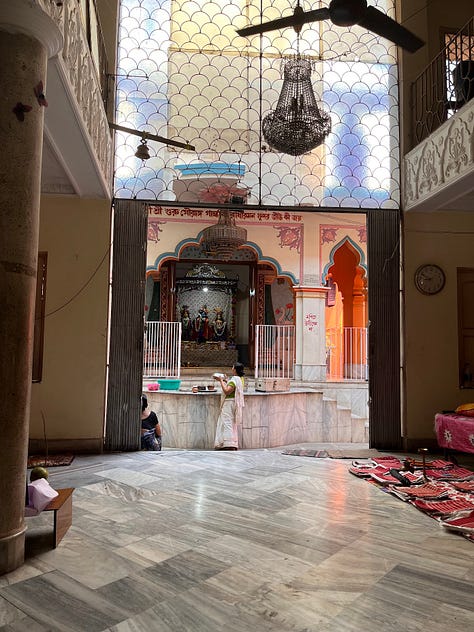
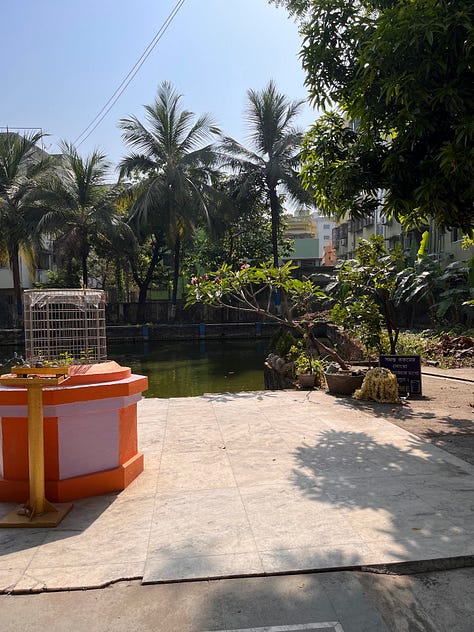
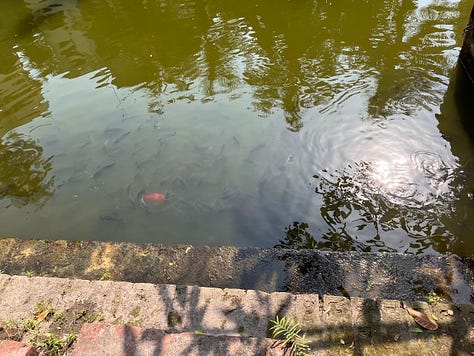
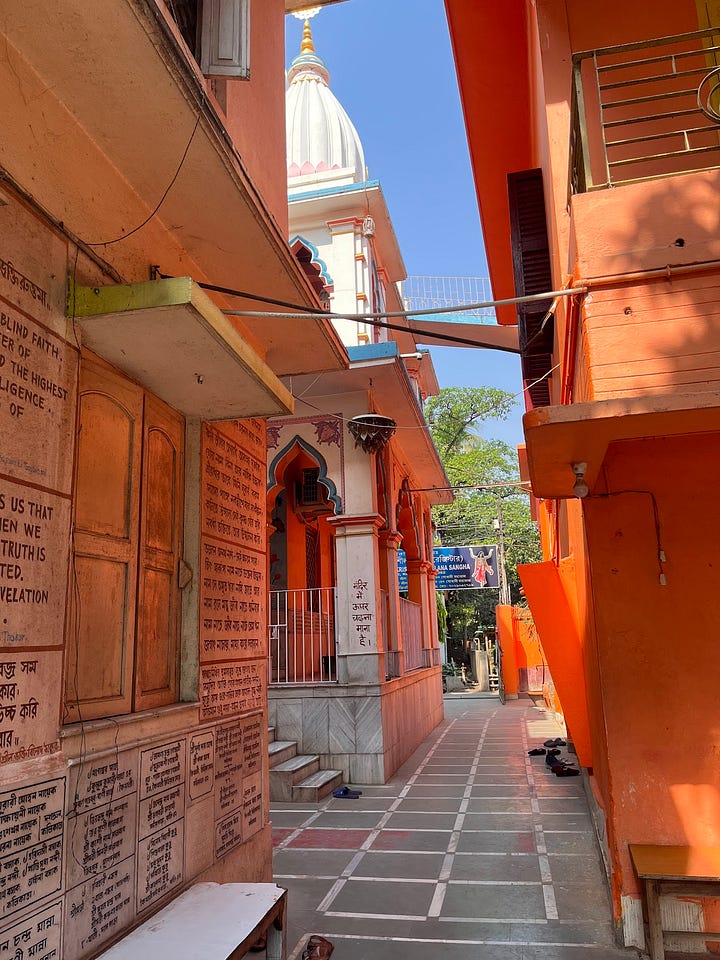

The serenity enveloping the matha’s atmosphere transcended the hustle and noise of the city, as if the gate was a portal to a realm charged with the energies of master meditators and saints. At one point during the ritual, as I sat on the floor offering water to my ancestors, a total dissolution of self — the self entrenched in a carefully crafted identity — washed over me like a bucket of cold water. I withdrew into silence for many hours afterwards. I felt like all my ancestors. And yet, I was no one. A remnant of dreams long gone. A shadow cast by dreams yet to be born. The sense of serenity transcended the physical realm of dukkha9 that dominated the undertone of that day.
I circled the perimeter like a hungry avian watching over its nest, when suddenly I saw my mother break into inconsolable sobs. An invisible umbilical pulled me in her direction. My feet followed the gentle pull as I held her shoulders and reminded her that Papa was a traveler of this realm, like the rest of us. Each of us is destined to walk through the veil onto the other side — into the great unknown. Until then, we are still here.
My grandmother, although a cinephile and pragmatic woman, was born and raised in the Vaishnava sect. Her father was a high priest and mystic of the respected Gosain10 clan from their lost homeland of Mymensingh11. It is said that he experienced multiple dream visitations from his Ishta Devata12, Radha-Raman, during his lifetime. Growing up in her mother’s shadow, my mother held great affinity and devotion toward this particular tradition. With Papa’s death anniversary finally behind us, my mother was free to begin her pilgrimage to the holy sites of her faith. She wanted to visit the district of Nadia — birthplace of the great saint Sri Chaitanya Mahaprabhu, founder of the Gaudiya sect of Vaishnavism — now known as home to West Bengal’s largest ISKCON precinct.
Since I have wandered along the perimeters of death’s territory, I am agnostic about the understanding of God. I know at least this much: there are three facets to life’s existence — the known, the unknown, and the unknowable. In my map of existence, the presence of God resides in the territory of the unknowable. My religion, if any, lies within the bounds of lush nature — forests, birdsongs, mountains, rolling hills, cascading valleys, rivers, seas, dancing storms, and crackling clouds — that sort of thing. However, I agreed to take Maa on a pilgrimage, since religious tourism made her happy.
We left Kolkata to catch our train from the historic Howrah station at the break of dawn, 5:00 a.m. I had almost forgotten how gorgeous and grotesque the old city lanes were. Skeletons of what once were robust offices of the British colonial administration, their red-and-white brick walls stood as a testimony to the passage of time between then and now. Almost all great rebellions and wars for India’s freedom from colonial rule started in this city — the city I call home. It is easy to forget the past when one lives in freedom, autonomy, and peace. The architectural shadow of the empire reminds me of the power of time — of its gigantic waves that render almost everything humans have ever built obsolete, even something as incredibly massive as the British Raj. It humbles me.
Kolkata is a kaleidoscope of human habitation, cramped into busy urban spaces. The urban commute here is wildly awakening and sobering, almost brutal in its sensory overload. The bustling streets, vehicle exhaust, bellowing cacophony of horns, raw dust spiraling wildly in all directions, sparks flying from hammer on steel, vivid artifacts and items of curiosity and necessity gathered in street vendors’ makeshift shops along every pavement, fresh flowers stacked in technicolor pyramids to be offered to our old gods, and an overwhelmed olfactory with the scent of freshly fried fritters, breads, and sweets — it was quite the morning for a sensitive person like me.
I reached Howrah station, half exhausted from the anticipation of being there after 11 years, and half sick from the uncanny memories of this city. I remember it as clearly as day — the last time I was here, my father came to drop me off when I was taking a train to the south of India. I insisted him not to come, but he did anyway. I insisted him not to stay with me and wait for the train, but he did anyway. Now I know what love meant for him and how many miles he’d walk for it. We embarked on several journeys together — across the country — from this same old station. Countless were our shared meals on the move, immeasurable was his exhaustion, but he was there. Always there.
I feel like I have entered a long-term agreement with grief — it is like living inside a perpetual state of anemoia: a nostalgia for a life that was never mine to begin with. The past betrays me; it treats me like a stranger. It puts words in my mouth and leaves me yearning for their taste — a ghost I have never known. There are so many dimensions to grief. When I am tuning in, occasional epiphanies and transpersonal experiences make it a worthwhile journey, but there is a catch. The journey is an unending one. It is a long and winding road that one must tread with all they have because there are no ways to undo the past — with all its joy and regrets. Memories remain episodic in nature — strong is their pull. Grief teaches you to be in the present — to cherish the sacredness of the now. It clears your vision so you can see the fragility of each moment, so you can learn to live here, now, with complete equanimity. But you yearn; your brain foams up memories you want to cling to even when they hurt. Time is a brute — a friend and a bully packaged into one. It promises you an end, but not now. For now, you have to live. You can live in the peace of now and watch it wash away all that is dear to you, or you can wallow in the past — the choice is yours.
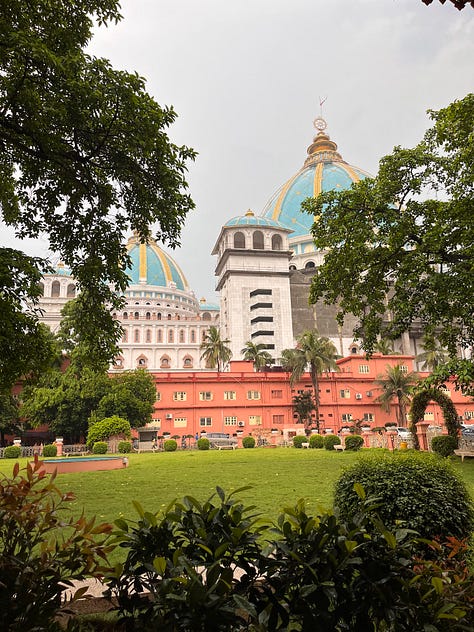

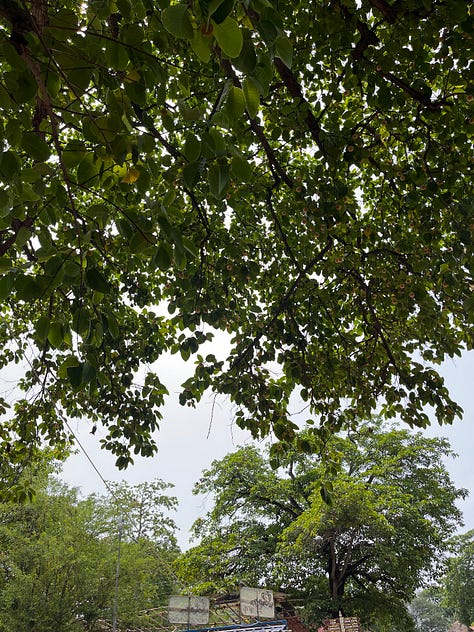
Torrential rain welcomed our arrival as we reached Nabadwip station, ready to board the overcrowded ferry crossing the Bhagirathi13 river, which splits the island into two shores — Nabadwip and Mayapur. The city of Mayapur is a gorgeous one. We rented a countryside Airbnb tucked away amid vast farmlands, surrounded by wild groves of tropical trees — guavas, bananas, jackfruits, sapotas, custard apples, and wild white and red hibiscus growing sporadically along the Jalangi14 river flowing right next to the community grounds where we were staying.
The schedule for the next two days involved only temple visits and being swept up in tides of people doused in spiritual fervor — dancing, singing, chanting in rhythms of bhakti bhajans15 across the ISKCON campus. I was a religious pariah in the sanctuary of Hare Krishnas, a fact I kept well hidden in the spirit of my journalistic curiosity. Yet, I encountered something magical, almost otherworldly, within the campus.
Due to its lush and ecocentric spiritual atmosphere, Mayapur is home to many migratory birds, and spring is their mating season. Standing at the entrance of the main temple, I heard a mysterious birdsong from beneath a mature burflower tree. Tired after our long journey and the day-long wait to see the evening aarti16, I took a small break to rest my aching heels after scouting the whole campus. The evening was turning golden, with robin-blue vistas ahead after long hours of rain, while people waded through puddles of grey and brown dirt. And there she was, singing. I couldn’t see her perched on any branch when I looked closely. It was a beautiful but strange song — it almost tasted of longing, of residual memory, loss, remembrance, or something in between. Maybe she was yearning for her home, or maybe she was trying to claim this tree as her own. Right here, a stranger to the land — visiting, remembering, claiming her space for her experiences — she mirrored the turmoil of my inner landscape. She was a pariah — probably solitary and terrified of this new world, but she too refused to leave, with her song still inside of her.
Song of the Greater Coucal, endemic to Vietnam
My mother was radiant and happy after attending the evening aarti and darshan17. I was content that my time there intersected with the mysterious tree dweller. The weather was comforting, and the heat had waned after the day’s showers drenched the spiritual town. Maybe we all meet God in our own ways — some within the premises of organized religious communities, some in birdsongs, and some in surrender to the mysteries of existence.
There is a war looming at the border of my country — but there is also a quiet revolution of reconnection unfolding within the psyche. If we must confront the hostilities of the world, let us do so not with borrowed rage, but with the strength of our inner reconciliation, seeking perhaps a new plenitude found in this quiet revolution of reconnection. Let us bring God along for the conversation — not as a distant savior, but as the part of us that remembers how to love even in the face of rupture.
Berkana is a non-stripe based reader-supported publication. To support my work, consider becoming my patron through Paypal.
Baisakh (Vaisakh): Hindu month (approx. April-May), marking a solar new year
Nadia: A district in West Bengal, India, historically and culturally significant, encompassing Nabadwip and Mayapur
ISKCON (Hare Krishnas): International Society for Krishna Consciousness, a Gaudiya Vaishnava movement
Barsi: Hindu ritual for the first death anniversary
Matha (Mutt): Hindu monastery or religious center
Kund: Man-made pond or reservoir, often near temples
Radha-Raman: Name for Lord Krishna as the one who pleases Radha (his consort)
Vaishnavism/Vaishnava: Hindu tradition (or follower) worshipping Vishnu or his avatars (like Krishna)
Dukkha: "Suffering" or "dissatisfaction"; a core concept in Buddhist/Hindu thought
Gosain (Goswami): Title for religious leaders, often in Vaishnavism
Mymensingh: City/district, formerly in Bengal (now Bangladesh)
Ishta Devata: A personally chosen or favored deity.
Bhagirathi River: A sacred headstream of the Ganges River
Jalangi River: A branch of the Ganges river system in West Bengal, India
Bhakti Bhajans: Devotional songs expressing love for a deity
Aarti: Hindu ritual of offering light to deities, often with song
Darshan: Auspicious sighting of a deity or holy person


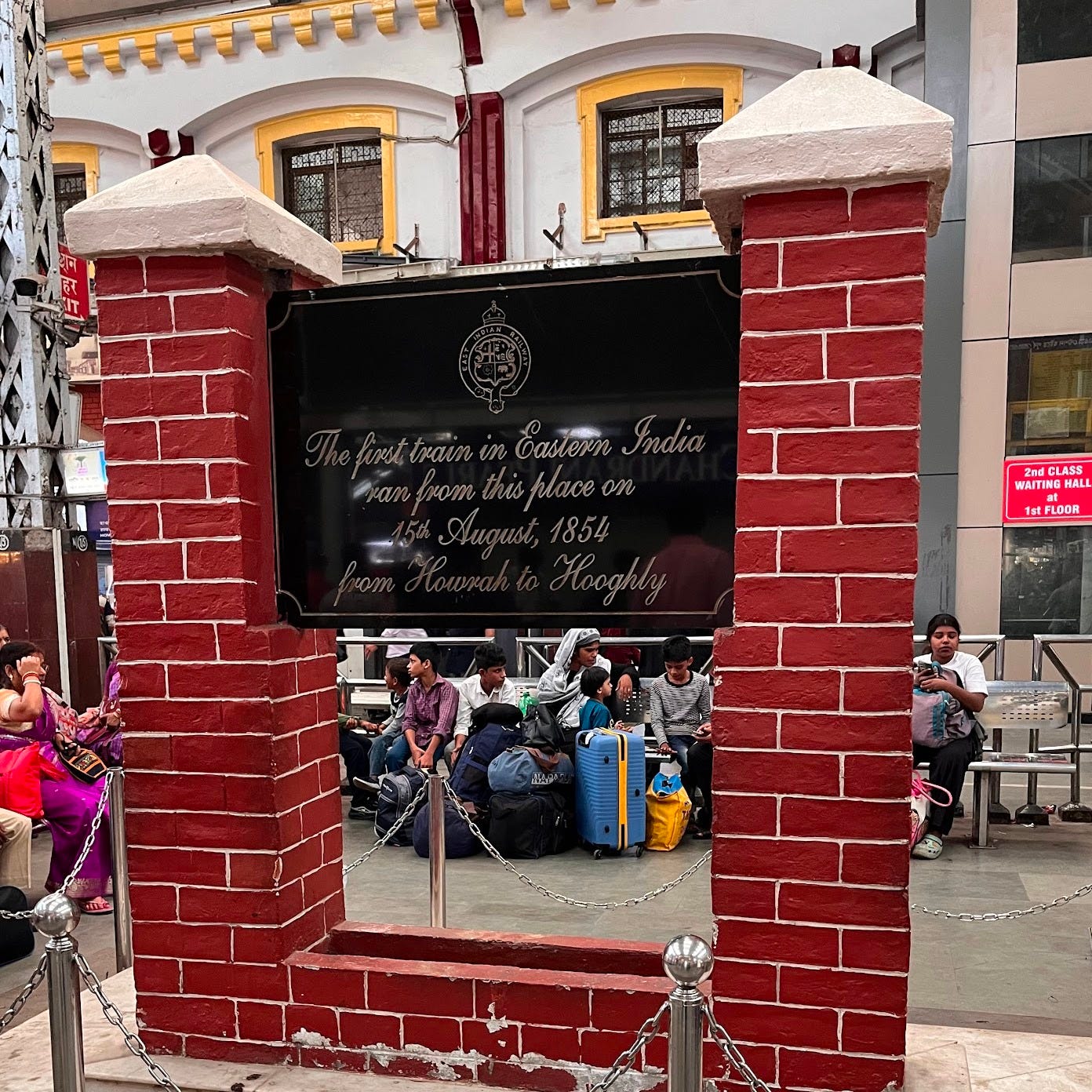
As usual I am utterly captivated by your writing. Intelligent, insightful, poetic, deeply humane. I always feel closer to understanding reading you.
This piece is just so full. To me, it feels representative of life, all the emotions, the events, the relationships that we pass through and that are passing through us all the time, and then the weather that runs through it all. Your experiences are always like companions to me, even though our cultural contexts are different (thank you for the work of the footnotes; they are much appreciated). The cold bucket of water that is the dissolution of self is so evocative. Thank you as always.